Truck bed liner types — pros and cons
Truck bed liner types — pros and cons
Why buy a truck bed liner?
Pickup trucks are designed to haul materials and tools and that automatically means the bed will be subjected to scratches, gouges, and dents. A truck bed liner can reduce the likelihood of that damage. That’s why many pickup truck owners start shopping for a truck bed liner right after they purchase a new pickup. Others wait until they notice the damage—scratches, gouges, and dents. However, as long as the bed is structurally sound and rust-free, you can install a truck bed liner to prevent future damage. This is a primer on the truck bed liner types and the pros and cons of each
Fives types of truck bed liners
In addition to preventing bed damage, a bed liner can also reduce material and tool movement while driving. There are four types of bed liners:
Drop-in bed liner
Drop-in bed liners are made from a large plastic sheet that’s often vacuum formed to a mold replica of your truck bed. The sheet is heated until it’s soft and then sucked onto the mold. The manufacturer drills mounting holes in the finished product. Many designs bolt into place using factory holes while others require drilling.
Professionally applied spray-on bed liner
You’ll find many brands of professionally applied truck bed coatings. The applicator prepares your truck bed and sprays on a thick coating on top of the factory painted bed. The bed liner coating protects against abrasion, movement and water damage.
DIY spray-on liner
DIY spray-on bed liner products usually come in a kit with prep materials and the liquid coating. Some kits include the spray gun, while others charge extra. Even if you own a spray gun, you should always use the spray gun recommended by the manufacturer to achieve the best results.
It goes without saying that you’ll also need an air compressor that can output the recommended cubic-feet-per-minute (CFM) airflow. If your air compressor outputs less than the recommended CFM, you simply won’t achieve the best results.
If you don’t own a compressor of that size, don’t risk it with a smaller compressor; consider renting one for the day.
Some companies also sell aerosol cans of bed liner coating. It is my personal opinion that you won’t be happy with the results from these products.
Finally, some DIY spray on bed liners are single-stage, while others are two-stage. See the heading below to learn more about the differences between the two types.
DIY roll-on liner or brush-on bed liner
These bed coating products are designed for application with either a foam roller or brush. They require prepping the bed before application and usually require multiple coats to achieve the desired build thickness.
Bed rug or bed mat
A bed rug liner or bed mat can be a flat custom cut rug/mat that fits only the floor area of your truck bed, or it can be custom molded to cover the floor and sides. The material is usually polypropylene/polyester fiber fabric and may include a synthetic pad underneath to cushion the load.
Single versus two-stage liner products — DIY and professionally applied
Some of the products are single-stage, which means they apply right from the can like paint and then air-dry/cure. These products have some pretty tight temperature and humidity requirements for application, so follow them exactly for the best results.
Others are two-stage products which means you mix in a catalyst hardener/activator before application. A two-stage product will always have a time-limited “pot life,” which means you must use the product within that time period or it will begin to harden in the container.
Depending on the type, this bed liner is either a single-stage water or solvent based paint or two-stage epoxy material that you roll or brush onto the factory paint.
The pros and cons of each type of the truck bed liner types
Drop-in liner pros and cons
Drop-in truck liner pros
- No prep. You don’t have to disturb the factory finish. You don’t have to sand or solvent wash. Just sweep the bed and drop in the liner. Attach the liner using factory holes (if equipped)
- Protects bed floor, sides and rails against abrasion
Drop-in truck liner cons
- Moisture can collect between the drop in liner and the bed and form rust. No matter how tightly molded to your truck bed, water and moisture WILL enter and it WILL sit in those pockets and rust out your truck bed.
- Some drop-in bed liners require drilling, which will defeats the factory anti-corrosion treatments applied at the factory. The instant you drill, you create a potential rust spot.
- Cracking. Drop-in bed liners tend to crack and craze as they age, creating even more potential for water leaks into the truck bed. If you opt for a drop-in liner, be prepared to REPLACE it when it starts to craze or crack
- Slippery. Drop-in bed liners come with a lightly embossed textured finsih, but that texture wears off over time which decreases skid resistance.
- Drop-in liners cost more than DIY spray-on, brush-on and roll-on products
Professionally applied spray-on bed liner pros and cons
Professionally applied spray-on liner pros
• More uniform appearance that a DIY application.
• Professional spray equipment can sometimes achieve a heavier build thickness than DIY spray application
Professionally applied spray-on liner cons
• Most expensive of all truck bed liner types
• Scratches must be repaired by the same company that applied the original coating
DIY spray-on bed liner pros and cons
DIY spray-on liner pros
• Lowest cost of all types
• You can perform scratch repairs yourself using the same material
• Single stage spray-on bed liner products have very high coverage rates so you can coat your bed with less product
• Two and three-stage bed liner products have much lower coverage rates but contain higher “solid” content—the component that actually stays on your truck bed after curing.
DIY spray-on liner cons
• Single-stage spray-on bed liner coating simply aren’t as durable, scratch-resistant or UV resistant as a two-stage or three-stage formula. Whether the product is water or solvent-based, they dry through evaporation. Their advertised coverage rate, as high as 125-sq/ft per gallon is misleading because most of the product is water or solvent. Once that carrier evaporates, you’ll be left with very little solid material, and it’s the solid content that provides the bed protection. In other words, single-stage spray-on bed liner liquid is more like paint than an actual bed liner type coating.
• Some two-stage spray-on bed liner products are epoxy-based which isn’t as durable or long lasting as a polyurethane product.
• Requires a compressor
• Requires some practice to achieve most pleasing results
• Must be completely applied during the “pot time” shown by the manufacturer.
• Requires dilagent surface preparation for best results
• Requires a spray gun and spray gun cleaning.
DIY roll-on bed liner or brush-on bed liner pros and cons
DIY roll-on liner or brush-on liner pros
• No compressor or spray gun required
• No overspray
• Easier cleanup. Just toss the roller and brush.
DIY roll-on liner or brush-on liner cons
• Uneven application as roller deposits more or less material as it rides over floor ribs
• Drips and sags due to uneven application.
Bed rug or bed mat pros and cons
Bed rug or bed mat pros
• High skid resistance
• Softer on knees when loading
• Protects cargo better than a coating
Bed rug or bed mat cons
• Allows water to pool under bed rug, causing bed rust
• Rug gets wet and stays wet after rain, possibly damaging your cargo.
• Best bed rugs cost far more than a good quality coating.
How to shop for a DIY spray-on bed liner product
Skip the manufacturer’s claims and go right to the specs.
Is the bed liner product single-stage, two-stage or three-stage?
You’ll get the best protection from a two-stage or three-stage product
Is the bed liner an epoxy or polyurethane system?
In most cases, polyurethane provides the longest life, best scratch resistance and best UV protection.
What is the coverage rate versus solids content?
Generally speaking, the LOWER the coverage rate, the HIGHER the build rate and the better the protection. For example, Al’s Liner covers only 22-sq/ft per gallon if you apply it at 1/16″ thickness. Obviously, you’ll get more coverage out of a gallon if you apply a thinner coat. But the point here is that coverage rate alone is misleading, because you also have to consider the solids content.
The Al’s liner product is 85% solids which means most of what you apply will remain on the truck bed once the cures. And it’s the solids portion of the bed liner product that protects your bed, not the solvent that evaporates into thin air. Since the whole point of adding a truck bed liner is to protect the truck bed, choose a product with the highest solids content.
Some companies don’t list their “solids” content. Without that, you really don’t know what you’re getting.
What is the maximum build rate?
Some products limit you to a very low build rate of 1/32″. That’s often not thick enough to provide adequate scratch protection for your truck bed. Generally speaking, the higher the build rate, the more protection you have against scratches and gouges.
What truch bed liner colors are available
Most DIY truck bed liner products come in black, grey or white. But some companies offer tint additives. If the color is important to you, check out the additives available.
What sheens are available?
Some products cure to a naturally glossy finish. You may like the “wet look” but there is a downside to a glossy finish; it shows off scratches and defects more than a matte finish. If the product you choose cures to a glossy finish, ask if they offer a matte finish additive to mix into the product to reduce the sheen.
What texture and appearance additives are available?
Spray-on truck bed liner products contain a grit additive to provide skid resistance. But some manufacturers off additional products like rubber crumb and appearance flakes. Check out all the options before you begin your project.
Popular bed liner brands
A quick search of truck bed liners shows that Al’s Liner, Herculliner, U-Pol Raptor, Rustoleum, and DupliColor are some of the most popular brands.
Based on a quick review from the manufacturers’ websites, here are some product stats on the different products:
Al’s Liner
Approx $80 for 1-gallon kit on Amazon and $120 for same kit with Al’s spray gun
Solids: 85%
Type: Three-part high solids Polyurethane with high tensile and tear strength, UV stability, no added fillers or solvent.
Build rate: up to 1/8″
Colors: Black, Grey, Tan, Olive Green, Orange, Dark Blue and tintable base
Repairs: Product bonds to itself
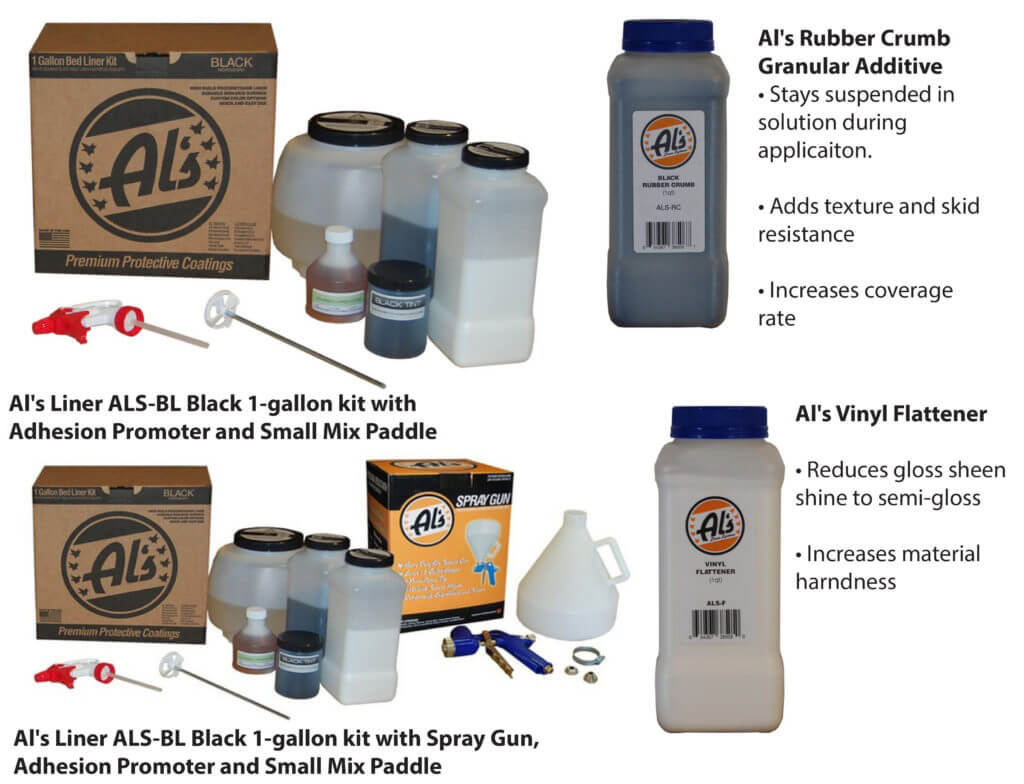
U-Pol Raptor Kit
Cost: Approx $108 for basic kit on Amazon. $120 with spray gun
Solids: Not listed on site
Type: Two-part Polyurethane with UV
Build rate: up to 1/32″
Colors: White, black and tintable base
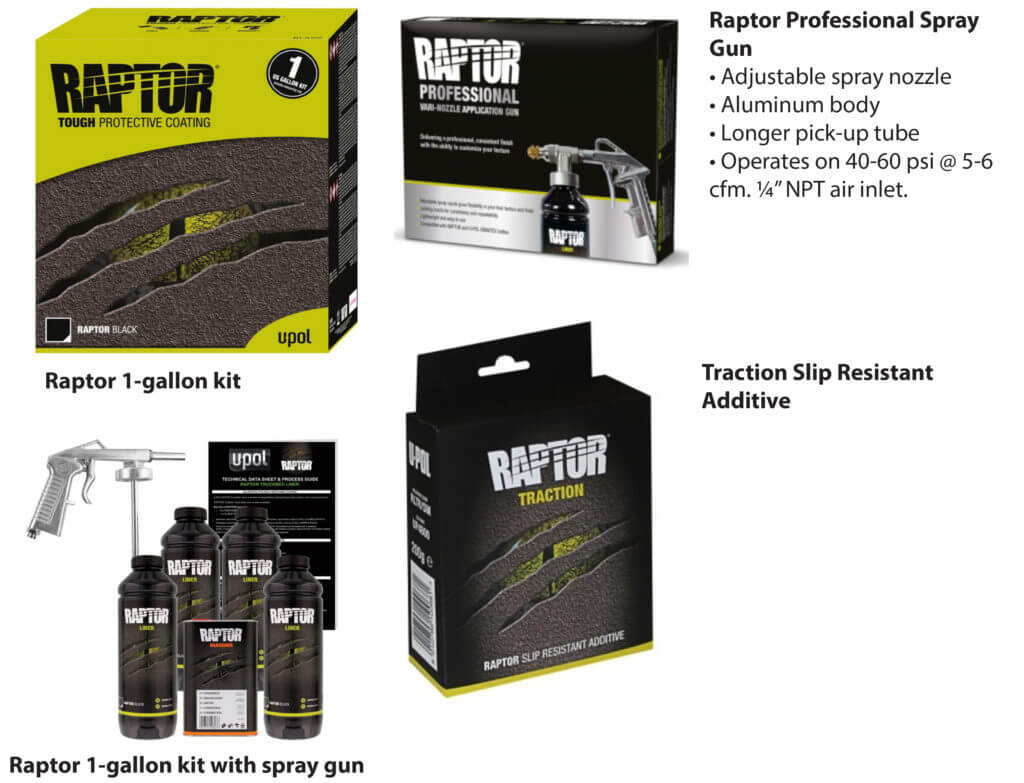
Herculiner Bed Liner
Cost Approx $72 on amazon 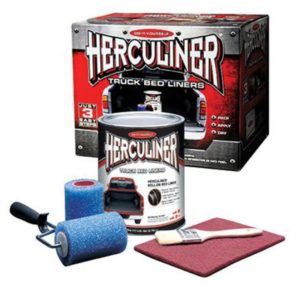
Solids: Not listed on site
Type: Single-stage Polyurethane with rubber
Build rate: Two coats recommended. Max build rate not listed
Colors: Gloss black or grey
Dupli-Color Bed Armour
Cost: Approx $28 on amazon
Solids: Not listed on site
Type: Water based Single-stage Polyurethane
Build rate: Two coats recommended. Max build 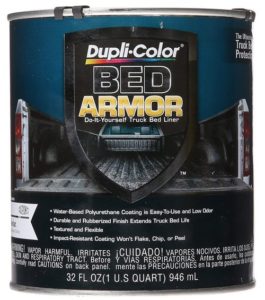 rate not listed
rate not listed
Colors: Gloss black or grey
Rustoleum Truck Bed Coating
Cost: Approx $19 on amazon
Solids: Not listed on site
Type: Water based Single-stage
Build rate: Two coats recommended. Max build
rate not listed
Colors: Black
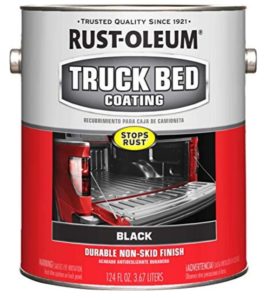
©, 2019 Rick Muscoplat
Posted on by Rick Muscoplat